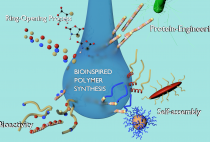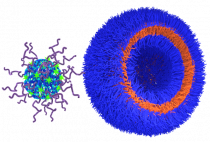I am biochemist by training and I did my PhD thesis in polymer chemistry to become an expert in ring-opening polymerization, a polymerization process that I have deeply studied experimentally (Chem. Commun. 2008, Biomacromolecules 2009, Chem. Eur. J. 2013) and by theoretical DFT methods (Chem. Eur. J. 2008). In order to combine this expertise with new skills in biomaterials development, I decided to move to Canada to join the Western University. As a postdoctoral associate in the Gillies lab, I developed unique elastomeric rubber with antifouling properties (2 patents WO, Macromolecules 2010, Macromolecules 2011, ACS AMI 2011). I also designed dendritic analogues of cell penetrating peptides and simple synthetic methods to graft them onto nanomaterials (Pharmaceuticals 2010, J. Polym. Sci. 2011, J. Matter Chem. 2012, Soft Mat. 2012). In a second postdoc position, I used all this experience to develop nanomaterials based on polypeptides (Polymer self-assembly group at LCPO/CNRS, JACS 2012, Chem. Commun. 2012). Combined to polysaccharides, I designed glycoprotein-like multivalency by polypeptide self-assembly (Farad. Disc. 2013, Chem. Commun. 2014, Chem. Commun. 2016).
I then joined in 2014 the “medicinal chemistry and biomimetic oxidations” group at LCC/CNRS, which specializes in bioinorganic chemistry and infectology. I developped new methodologies to synthesize N-carboxyanhydride (NCA) monomers and to perform their ring-opening polymerization. For instance, I developed unique polymers mimicking metalloproteins and nucleoproteins by using reversible interactions based on coordination chemistry or on DNA binding (Chem. Commun. 2017, Polym. Chem. 2017 and 2018, Biomacromolecules 2018). Such polypeptides are currently used to prepare new classes of bioinspired piezoelectric nanocomposites (Nat. Commun. 2020) or DNA-responsive nanomaterials (Polymers 2020, Biomacromolecules 2022).
After my Habilitation thesis (November 2018), I have decided to move back from Toulouse to Bordeaux to better develop breakthrough methodologies using ring-opening polymerization of N-carboxyanhydride at LCPO. Thanks to a unique collaboration with the Pasteur Institute, I have for instance achieved ring-expansion methodologies to mimick antimicrobial peptides (Biomacromolecules 2021, JACS 2021, Patent 2022 WO2022175319A1). Other main achievements include the development of aqueous ring-opening polymerization induced self-assembly processes (ROPISA, Angew. Chem. Int. Ed. 2020, VIP Paper, Patent 2021 WO2021/043865) or the use of aqueous ring-opening polymerization towards protein-like polymers with thermoresponsive properties (Angew. Chem. Int. Ed. 2022, Hot Paper).
Overall, my research developments have already resulted in patents and publications in major journals related to chemical sciences (JACS, Angewandte, Nature Communication...). My in-depth expertise in NCA chemistry as well as the new tools I developped recently in ring-opening polymerization is an excellent platform to conceive the polymers for tomorrow’s application following bioinspired and biomimectic polymer design.






